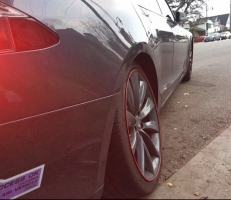— A Tesla control arm failure lawsuit alleges Model S and Model X vehicles have front and rear suspension control arm assembly components that prematurely loosen, wear out, crack and break.
The Tesla control arm failure class action lawsuit says the Model S and Model X vehicles were built between September 17, 2013, and October 15, 2018.
According to the lawsuit, the automaker concealed defects in the Model S and Model X suspensions because Tesla allegedly knew the vehicles would have diminished values.
The automaker also allegedly concealed the suspension problems because owners would be aware of the high cost for repairs and replacements.
California plaintiff Zachery Williams purchased a used 2016 Tesla Model S online from Tesla in August 2019 with 54,492 miles on the odometer. His Model S suffered a rear lower control arm failure in February 2020 allegedly while driving 65 miles per hour.
The plaintiff says he noticed a wobble and heard a grinding noise before finding the rear passenger-side lower control arm had broken off the steering knuckle and caused the wheel to fold inward.
The Tesla Model S control arm failure occurred when the car allegedly was still covered by the warranty, but a Tesla service center wouldn't pay for the control arm repairs.
According to the lawsuit, Tesla said the control arm failure was caused not by a defect but from a pothole or damage caused by the previous owner. The class action alleges Williams was required to pay $2,090 for the control arm repairs.
The plaintiff says control arm failures can occur without warning and leave drivers without steering control. The rear and front control arms can allegedly separate from the steering knuckles and cause negative camber in the suspension.
The class action describes “camber” as the angle of the wheel measured in degrees when viewed from the front of the vehicle. If the top of the wheel is leaning outward from the center of the car, the camber is positive, and if it leans inward the camber is negative.
Although a car that wobbles is one thing, the plaintiff claims some Tesla owners report their wheels completely detached because of control arm failures.
The allegedly defective components include the "front upper and lower control arms, front suspension aft-link, front suspension fore link, rear suspension upper link assembly, and rear suspension lower control arm assembly."
According to the class action, the China State Administration for Market Regulation in October announced Tesla would recall about 40,000 Model S and Model X vehicles. The vehicles were recalled for suspension problems.
However, Tesla allegedly tells U.S. customers the control arm and suspension problems are caused by driver abuse and the China situation doesn't apply in the U.S. because “driver usage and expectation for damageability is uniquely severe in the China market."
Tesla Control Arm Failure TSBs
Tesla allegedly admitted in a 2015 technical service bulletin (TSB) that the front and lower rear control arm assemblies on certain 2013-2014 Model S vehicles might crack, instructing its service centers to replace the failed components with “updated parts.”
The plaintiff says Tesla has issued three technical service bulletins due to suspension problems, but some of the vehicles have allegedly been left out of the bulletins.
"The front lower control arm ball joints [in 2012-2013 Model S cars] might develop greater free play than is expected. This can result in a clicking or clunking sound from the front suspension when driving over large bumps. If left uncorrected, the ball joints could be subject to accelerated wear. Over time, the clicking or clunking noises will become louder as the ball joint wear increases, leading to required premature replacement of components." - Tesla TSB-13-31-003
“Some [2016] Model S and Model X vehicles may have been manufactured with front suspension fore links that may not meet Tesla’s strength specifications. In the event of link failure, the driver can still maintain control of the vehicle but the tire may contact the wheel arch liner.” - Tesla TSB-17-31-001
“On certain [2013-2014] Model S vehicles, lower rear control arm might crack, causing excessive negative camber of the rear suspension.” - Tesla TSB-19-31-001
According to the Tesla control arm failure lawsuit, the automaker has redesigned and strengthened the suspension components because of the alleged defects.
The Tesla control arm failure lawsuit was filed in the U.S. District Court for the Northern District of California, Oakland Division: Williams, et al., v. Tesla, Inc., et al.
The plaintiff is represented by McCune Wright Arevalo LLP.

